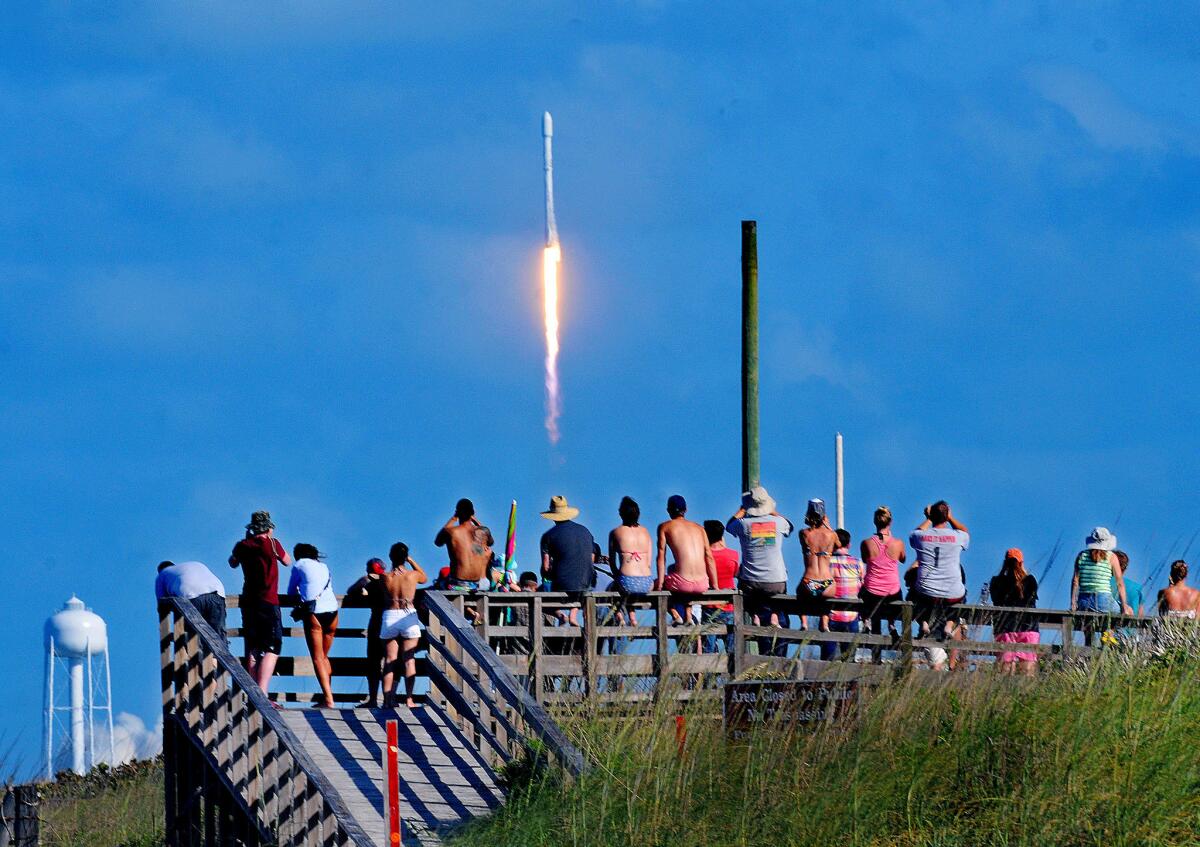Rocket science? Check. But can SpaceX get through insurance hurdles?

Crowds pack the Canaveral National Seashore on May 27 to witness the liftoff of a SpaceX Falcon 9 rocket with the THAICOM-8 satellite aboard.
- Share via
Now that SpaceX has made rocket landings somewhat routine, the next step is to prepare the recovered rockets for reuse to launch commercial satellites. Some of the technical hurdles it must clear also have financial implications.
In the next two weeks, the Hawthorne space company will brief domestic and international insurance underwriters on its progress. As part of that regular annual review, they will discuss upgrades to the company’s Falcon 9 rockets, as well as its plans to reuse them.
SpaceX will need to determine how many launches it can get out of each reusable rocket as well as the costs of refurbishing them, said Michael Blades, senior industry analyst for aerospace and defense at consulting firm Frost & Sullivan.
Insurers have already given Falcon 9 a “tremendous amount of support” because the rocket has proved reliable so far, said Jeffrey Poliseno, chief executive of Aon International Space Brokers.
“It’s a matter of keeping the market educated on what’s going on,” said Poliseno, who will be attending the meetings with insurers. “Generally when you do that and demonstrate something works, they’ll be very supportive.”
As SpaceX has accumulated mission successes, launch insurance rates have fallen. Insurers rate both the risk of launch vehicle failure as well as the chances that a satellite will fail and combine the two to get a coverage rate. Over the last two years, Poliseno said the Falcon 9 insurance rate has dropped nearly 50%.
Now the rate for the first-time launch of a SpaceX rocket is about the same as for French launch provider Arianespace’s Ariane 5, a “workhorse” commercial launch vehicle long known for its reliability, Poliseno said.
“It’s a vote of confidence from the insurance community,” he said.
Chief Executive Elon Musk has said SpaceX expects to get to a point where there is little work to be done between reuses other than refilling the propellant tanks. But the company is putting its first landed boosters through rigorous tests to determine each rocket’s condition after reentry.
Once the boosters land on the droneship and are secured, the ship heads to dock at Port Canaveral, Fla. From there, the boosters are transported by truck to testing sites in Texas or at Kennedy Space Center.
The first booster that landed at sea in April will be the first to be reflown in the next few months.
A booster that landed in May will undergo extensive analysis to determine where the structure of the engines was most stressed, since it was exposed to high velocities and heat upon reentry from a higher-than-usual orbit.
In addition to its three sea landings, SpaceX also landed a first-stage rocket booster on land in December. That booster has been test-fired and all nine engines were brought to full power. It won’t be reflown, though, but will be put on display at SpaceX’s headquarters.
Because insurers are always a little skeptical when something new is introduced, the information from the upcoming meeting will enable them to assess the risks of flying with a reusable rocket, Poliseno said.
SpaceX “can push the envelope a bit,” he said. “They have that credibility in the marketplace.”
SpaceX has increasingly driven down prices in the launch market, forcing competitors to scramble.
The company lists its starting price for the Falcon 9 rocket at $62 million. The average price of a launch with United Launch Alliance, a joint venture of Boeing Co. and Lockheed Martin Corp. that competes with SpaceX for national security satellite launch contracts, is $225 million.
SpaceX executives say prices could go down even further – potentially by 30% -- if the company is able to make good on its plans to offer reusable rockets for launch.
Competitors have speculated that SpaceX launches either at cost or at very small profit margins to drive business. Those financial details are not publicly available because SpaceX is a private company.
But even a cost savings of 10% to 20%, along with a track record of reliability for its reusable rockets, could help the company gain more market share, said Blades of Frost & Sullivan.
SpaceX said a number of customers have already expressed interest in launching their payloads on a reusable rocket. One of the most vocal is SES, a satellite operator based in Luxembourg that launched one of its satellites aboard a Falcon 9 three months ago and has a contract with SpaceX to launch six more.
Martin Halliwell, chief technology officer at SES, said in an interview this year that the company wanted to be the first commercial satellite operator to fly the same rocket twice.
This kind of customer interest is a good sign, said Phil Smith, senior space analyst at Tauri Group.
“If SpaceX had these reusable boosters and there was simply no interest out there in these, then that would be a red flag,” he said.
SpaceX’s next launch of a commercial communications satellite will be in mid-June.
ALSO
No free charging for Model 3? Tesla can explain
GM says its Takata air bag inflators are safe; government disagrees
Will more start-ups follow Uber in taking cash from sovereign wealth funds?
For more business news, follow me @smasunaga
More to Read
Inside the business of entertainment
The Wide Shot brings you news, analysis and insights on everything from streaming wars to production — and what it all means for the future.
You may occasionally receive promotional content from the Los Angeles Times.











